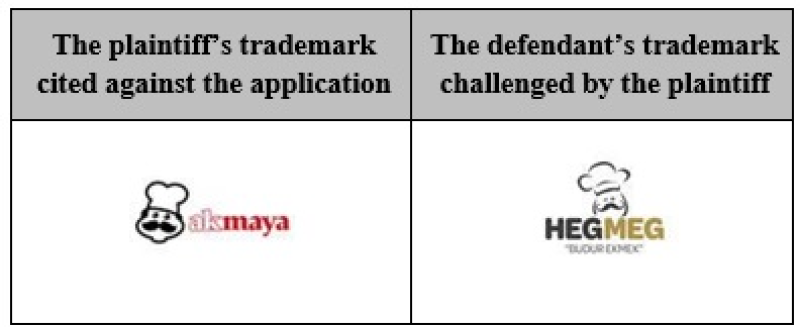Would you like to hear more about the chef’s recommendation? First, as a starter, some background information will be provided on a trademark dispute in Turkey that has a culinary theme, with the following steps taken at the administrative stage:

The owner of the above-left trademark opposed a third-party application for the above-right trademark before the Turkish intellectual property office, by addressing the entire coverage of the filing under the Nice Classification (see column A below);
The opposition of the plaintiff was partially accepted, and the opposed application was partially rejected for several goods and services (see column B below);
Upon an appeal by the applicant, the higher board of the office allowed the appeal partially, and returned several goods to the specification of the application (see column C below);
The applicant did not file a cancellation action to challenge partial refusal of its trademark application (see column D below) and proceeded with the registration for the remaining goods and services;
The plaintiff filed a court action to cancel the higher board’s decision and to invalidate the defendant’s trademark for all goods and services (see column E below).
Following the finalisation of the matter at the administrative stage by the higher board’s decision, the intellectual property court in question examined the plaintiff’s case and decided that since both parties’ relevant trademarks involve a chef figure, this would not create a likelihood of confusion when entire compositions of the signs are compared, due to the dissimilarities of the word elements.
Even though it is possible to admit that the plaintiff’s trademark has a certain reputation in terms of fresh and dry yeast, the intellectual property court was not of the opinion that the defendant’s trademark would derive unfair benefits from, or harm the reputation or distinctiveness of, the plaintiff’s trademark. Finally, the intellectual property court noted that there is no material evidence demonstrating bad faith of the applicant, and given all the above, the plaintiff’s case was dismissed.
The regional court of appeals then analysed the matter upon an appeal by the plaintiff, and agreed with the intellectual property court, adding that the word elements “budur ekmek” (“this is the bread”) alienate the trademark from the plaintiff’s and the common chef figure alone does not create similarity leading to confusion.
Upon further appeal, the Court of Cassation stated that since the defendant did not file a cancellation action to challenge the higher board’s decision ruling for similarity of the trademarks (the decision mentioned in column D below), with only the plaintiff filing a court action, the defendant should have been considered as “having accepted” the similarity of signs. The lower courts should only have compared and examined the goods and services, having recognised the similarity of the signs as non-contentious.
A | B | C | D | E |
Goods and services initially applied for under the Nice Classification | Goods and services partially rejected by the trademark department | Goods and services returned to the list by the higher board | Goods and services removed from the specification as a result of the higher board’s decision | Goods and services challenged by the plaintiff in the court proceedings |
16, 29, 30, 31, 32, 35, 40, 43 | 29, 30, 31, 32, 35 (only retail services) | Class 30 goods other than “[c]offee, cocoa; coffee or cocoa-based beverages, chocolate-based beverages. Flavourings for foods, sauces including vanilla, spices, tomato sauces. Yeasts, baking powders. Granulated sugar, cube sugar, powdered sugar.” (The plaintiff having earlier rights to the above.) | 29, 30 (only “[c]offee, cocoa; coffee or cocoa-based beverages, chocolate-based beverages. Flavourings for foods, sauces including vanilla, spices, tomato sauces. Yeasts, baking powders. Granulated sugar, cube sugar, powdered sugar.”), 31, 32, 35 (only retail services). | 16, 29, 30, 31, 32, 35, 40, 43 |
Implications of the decision for trademark owners in Turkey
This decision is significant as it requires parties to file court actions to challenge administrative decisions of the higher board of the Turkish intellectual property office even if the decisions are partially in their favour or disfavour. Otherwise, according to the Court of Cassation’s view, parties that do not challenge the higher board’s decisions would not be allowed to defend their positions in possible court actions filed against their trademarks, as they will be considered as “having accepted” what they did not challenge.
Although the authors do not agree with this interpretation by the Court of Cassation and hope it is a one-off, in light of this precedent of December 2024 on how the trademark owners’ actions, or refraining from taking actions, can limit the courts’ boundaries in assessing the similarity of trademarks, for now it is suggested that all trademark owners should consider exhausting all administrative stages before the trademark office as long as it is in line with their strategy, and to proceed with cancellation actions even if the trademark office’s decisions are partially in their favour. Otherwise, they may be considered as having accepted certain findings in those decisions, and they may lose their ability to defend their mark at later stages.












